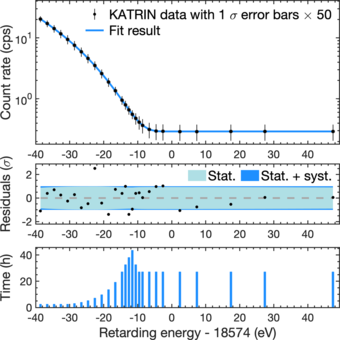Genauer als gedacht
Erste Ergebnisse von der Neutrinowaage KATRIN
2019-09-16 – Nachrichten aus dem Physik-Department
Neben Lichtteilchen, den Photonen, sind Neutrinos die häufigsten Teilchen im Universum. Die Entdeckung der Neutrino-Oszillation vor zwei Jahrzehnten lieferte den Beleg, dass sie – entgegen früherer Erwartungen – eine sehr kleine, von Null verschiedene Masse besitzen. Damit spielen die Leichtgewichte eine zentrale Rolle bei der Bildung von großräumigen Strukturen im Kosmos.

Auch in der Welt der Elementarteilchen, den kleinsten Bausteinen des Universums, ist ihre sehr kleine Masse von Bedeutung: Sie deutet auf neue Physik jenseits gängiger Modelle hin. Die weltweit genaueste Waage, das internationale KATRIN-Experiment am Karlsruher Institut für Technologie (KIT), soll nun in den nächsten Jahren die Masse der faszinierenden Neutrinos mit bisher unerreichter Sensitivität bestimmen.
Im Frühjahr 2019 legte das 150-köpfige KATRIN-Team zum ersten Mal Neutrinos auf die Waagschale – natürlich nur im übertragenen Sinn. Dazu ließen die Wissenschaftler/innen über mehrere Wochen hochreines Tritiumgas [1] in der Quelle zirkulieren und zeichneten die ersten Energiespektren von Elektronen aus dem Tritiumzerfall auf. Das internationale Analyseteam machte sich dann an die umfangreiche Arbeit, um aus den aufgenommenen Daten das erste Neutrinomassen-Resultat abzuleiten.

Verdeckte Ermittlungen führen zum Ziel
Eine zentrale Aufgabe fiel dabei Dr. Thierry Lasserre (CEA und Max-Planck-Institut für Physik/TUM) als Analysekoordinator zu: „Unsere drei internationalen Auswertegruppen haben in letzten Monaten bewusst vollkommen eigenständig gearbeitet, um drei wirklich unabhängige Resultate zu erhalten. Dabei war es wichtig, dass kein Teammitglied das Ergebnis für die Neutrinomasse im Voraus ableiten konnte“. Wie bei Präzisionsexperimenten heute üblich, wurden dazu wesentliche Zusatzinformationen bis zum letzten Analyseschritt verhüllt. Am Abend des 18. Juli 2019 wurden dann alle Daten freigeschaltet.
Damit konnten die zeitgleich gestarteten Programme über Nacht die Messdaten mit der Modellerwartung vergleichen und nach der charakteristischen Signatur der Neutrinomasse abtasten. Alle drei Gruppen vermeldeten identische Resultate, die die Neutrinomasse auf einen Wert von kleiner als 1 Elektronenvolt (eV) begrenzen [2]. Damit weist KATRIN schon nach einer ersten, kurzen Messphase die weltweit größte Genauigkeit für die Neutrinomasse auf.
Susanne Mertens, Leiterin der Gruppe am Physik-Department und am Max-Planck-Institut für Physik (MPP), hat eine der Haupt-Analysen der ersten Neutrinomasse-Daten koordiniert. Die dafür von der Arbeitsgruppe entwickelte Auswertungsstrategie wurde als zentrales Ergebnis dieser Messkampagne veröffentlicht. Daneben war die Gruppe maßgeblich an der Charakterisierung des Untergrunds beteiligt und übernahm wichtige Aufgaben bei der Kalibrierung der Tritiumquelle. Mertens: „Ich bin sehr stolz auf mein Team, das bei der anspruchsvollen Datenanalyse fantastische Arbeit geleistet hat.“

Wie viel Energie bekommt das Neutrino?
Die jetzt veröffentlichten Analysen [3] nutzen ein seit langem bekanntes Prinzip zur direkten Bestimmung der Neutrinomasse: Beim radioaktiven Zerfall von Tritium teilen sich das entstehende Elektron und ein das (Elektron-)Neutrino die freiwerdende Energie von 18,6 Kiloelektronenvolt. In sehr seltenen Fällen erhält das Elektron praktisch die gesamte Energie, während für das Neutrino nur ein winziger Bruchteil davon übrigbleibt, mindestens aber – gemäß Einstein – der Betrag E = mc² seiner Ruhemasse.
Von den etwa 25 Milliarden Elektronen, die beim Tritium-Zerfall pro Sekunde freigesetzt werden, haben die KATRIN-Wissenschaftler nur eine kleine Teilmenge untersucht: Sie filterten rund 2 Millionen Elektronen mit dem passenden Energiespektrum heraus, um die Neutrinomasse zu ermitteln.
Veröffentlichungen
- First operation of the KATRIN experiment with tritiumM. Aker, K. Altenmüller, M. Arenz et al.
- An improved upper limit on the neutrino mass from a direct kinematic method by KATRINM. Aker, K. Altenmüller, M. Arenz et al.
Weitere Informationen
Das KATRIN-Experiment wird am Karlsruher Institut für Technologie aufgebaut und betrieben. An der KATRIN-Kollaboration sind 20 Institutionen aus sieben Ländern beteiligt. Neben dem Karlsruher Institut für Technologie sind die deutschen Mitglieder: die Humboldt Universität zu Berlin, die Universität Bonn, die Hochschule Fulda, das Max-Planck-Institut für Kernphysik in Heidelberg, die Universität Mainz, das Max-Planck-Institut für Physik in München, die Technische Universität München, die Universität Münster und die Universität Wuppertal.
Verwandte Meldungen
- Ganz nah dran an den Geisterteilchen – 2019-09-05
- Hochdotierte EU-Förderung für Spitzenforschung – 2019-09-04
- Sternenstaub im antarktischen Schnee – 2019-08-22
- Erster Gesamtblick auf die Fusionsprozesse der Sonne – 2018-10-25
- Blazar beschleunigt kosmische Neutrinos auf höchste Energien – 2018-07-18
- Neutrinos auf der genauesten Waage der Welt – 2018-06-11
Kontakt
Fußnoten
| [1] | Tritium wird auch überschwerer Wasserstoff genannt. Im Gegensatz zum üblichen Wasserstoff, dessen Kern aus einem Proton besteht, besitzt das radioaktive Tritium ein Proton und zwei Neutronen. |
| [2] | Massen werden in der Teilchenphysik statt in Kilogramm entsprechend der Einsteinschen Gleichung \(E = mc^2\)in Elektronenvolt [eV] (als Einheit für die Energie)/Lichtgeschwindigkeit zum Quadrat angegeben, da der Zahlenwert sonst unpraktikabel klein würde: 1 eV/c2 entspricht \(1,8 \times 10^{-36}\) Kilogramm. |
| [3] | Die Analysen wurden auf der Fachtagung TAUP in Toyama, Japan, vorgestellt. Gleichzeitig wurden sie zur Veröffentlichung in einem renommierten Fachjournal eingereicht. |
